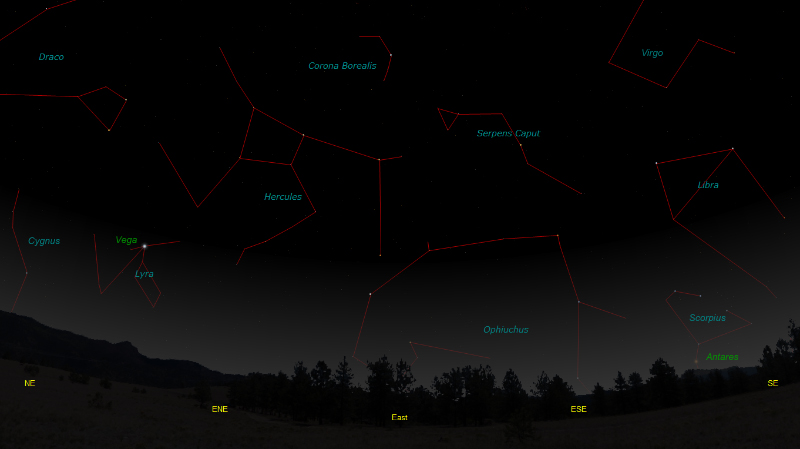The purpose of this feature is to give scout leaders, educators and naturalists an idea of some of the natural events coming up each month. We will try to cover a variety of natural events ranging from sky events to calling periods of amphibians, bird and mammal watching tips, prominent wildflowers and anything else that comes to mind. We will also note prominent constellations appearing over the eastern horizon at mid-evening each month for our area for those who would like to learn the constellations. If you have suggestions for other types of natural information you would like to see added to this calendar, let us know! Note: You can click on the hyperlinks to learn more about some of the featured items. To return to the Calendar, hit the "back" button on your browser, NOT the "back" button on the web page. All charts are available in a "printer friendly" mode, with black stars on a white background. Left clicking on each chart will take you to a printable black and white image. Please note that images on these pages are meant to be displayed at 100%. If your browser zooms into a higher magnification than that, the images may lose quality. Though we link book references to nationwide sources, we encourage you to support your local book store whenever possible. Notes and Images From April 2010 Although it is a common native tree in Tennessee, the Black Locust is fairly inconspicuous for most of the year. Many older trees are attacked by the Locust Borer beetle. This beetle weakens the trees, and the resulting loss of limbs gives them a somewhat ragged form. The damage also makes them unprofitable as timber. For much of the year, you might not give Black Locusts a second look. It is in the spring that Black Locusts really make their presence known. Towards the end of April and into May, these trees are covered with showy white flower clusters. Drive just about any back road in Tennessee, and you will find them. The white flowers look stunning against a blue sky.
Honey made from Black Locusts is sold under the name of acacia honey, and the tree is an important honey plant. The bark of the tree is very thick and furrowed. The wood, when free of insect damage, is extremely hard and strong. Like the Honey Locust, The Kentucky Coffee Tree and the Redbud, the Black Locust is a member of the legume family.
NGC 4565 is a classic edge-on galaxy in the constellation of Coma Berenices. The dark clouds of dust that ring the galaxy are prominent in silhouette. When we look up at the Milky Way on a clear summer evening, we see similar clouds of stars and dust that surround our own galaxy. On April 9th a cold front cleared the skies and we began taking images of NGC 4565 that evening. It took several nights to gather enough starlight for the image. The cool nights were pretty quiet except for the song of our resident Northern Mockingbird, who never seems to stop singing this time of year! NGC 4565 was discovered by William Herschel on April 6th, 1785, in his systematic survey of the sky. The galaxy is thought to be comparable in size to our own, and the distance is around 30,000,000 light years. There are many, many small background galaxies in the image (better seen on the high-resolution version) including a nice cluster of galaxies just off the right hand tip of the NGC 4565. To see the high-resolution version of the image above, click the image or click here. You will also find charts for visually locating the galaxy.
Sky Events for May 2010: Evening Sky: Beautiful Venus is bright and easy to see after sunset in the western sky this month. It will gradually climb higher in the sky after sunset as the month progresses. Mars is fading, but still prominent about 47 degrees above the western horizon at dusk at midmonth. As the distance between Mars and Earth continues to increase, the apparent diameter of Mars decreases from a little over 7 seconds of an arc to 6 seconds of an arc by the end of the month. Telescopic detail on the planet will be elusive. Look for bright Saturn about 56 degrees above the southern horizon at dusk at midmonth. The ringed planet is in Virgo. The rings are still pretty close to edge-on this month. Because of the diminished brightness of the ring system, you may be able to see fainter satellites of Saturn than you normally do with a given telescope. Morning Sky: Jupiter rises about 3:00am at midmonth, and it's nice to it again in the dawn sky. All times noted in the Sky Events are for Franklin, Tennessee and are Central Daylight Time. These times should be pretty close anywhere in the mid-state area.
Constellations: The views below show the sky looking east at 9:30pm CDT on May 15th. The first view shows the sky with the constellation outlined and names depicted. Star and planet names are in green. Constellation names are in blue. The second view shows the same scene without labels. New constellations this month in the eastern sky are Lyra, the Lyre, with it's bright star Vega, Serpens Caput, the head of the Serpent, and Libra, the Scales. The red giant Antares (the name means Rival of Mars) is just making its way over the eastern horizon in Scorpius. Ophiuchus, the Serpent Bearer, is also climbing into view.
On Learning the Constellations: We advise learning a few constellations each month, and then following them through the seasons. Once you associate a particular constellation coming over the eastern horizon at a certain time of year, you may start thinking about it like an old friend, looking forward to its arrival each season. The stars in the evening scene above, for instance, will always be in the same place relative to the horizon at the same time and date each May. Of course, the planets do move slowly through the constellations, but with practice you will learn to identify them from their appearance. In particular, learn the brightest stars (Like Vega and Antares in the above scene looking east), for they will guide you to the fainter stars. Once you can locate the more prominent constellations, you can "branch out" to other constellations around them. It may take you a little while to get a sense of scale, to translate what you see on the computer screen or what you see on the page of a book to what you see in the sky. Look for patterns, like the stars that make up the constellation Hercules. The earth's rotation causes the constellations to appear to move across the sky just as the sun and the moon appear to do. If you go outside earlier than the time shown on the charts, the constellations will be lower to the eastern horizon. If you observe later, they will have climbed higher. As each season progresses, the earth's motion around the sun causes the constellations to appear a little farther towards the west each night for any given time of night. If you want to see where the constellations in the above figures will be on June 15th at 9:30pm CDT, you can stay up till 11:30pm CDT on May 15th and get a preview. The westward motion of the constellations is equivalent to two hours per month. Recommended: Sky & Telescope's Pocket Star Atlas is beautiful, compact star atlas. It is destined to become a classic, and is a joy to use at the telescope. A good book to learn the constellations is Patterns in the Sky, by Hewitt-White. You may also want to check out at H. A. Rey's classic, The Stars, A New Way to See Them. For skywatching tips, an inexpensive good guide is Secrets of Stargazing, by Becky Ramotowski. A good general reference book on astronomy is the Peterson
Field Guide,
A Field Guide to the Stars and Planets, by Pasachoff. The book retails for around $14.00. Starry Night has several software programs for learning the night sky. Visit the Starry Night web site at www.starrynight.com for details.
Amphibians:
By the end of May all of Tennessee's frogs and toads are either calling or have already reached their peak calling period and are being heard less. The treefrogs are the last of our frogs and toads to start calling. Cope's Gray Treefrog and Gray Treefrogs start giving isolated calls as early as March, and by the end of this month listen also for Bird-Voiced Treefrogs, Green Treefrogs and Barking Treefrogs. In May we also hear Fowler's Toads calling frequently, so listen for their "crying baby" call. Northern Cricket Frogs are hitting their stride as well. Listen for a sound like two stones being tapped together. We have heard eight or more species of frogs calling on some May evenings, so it's a great time to listen. Upland Chorus Frogs and Spring Peepers continue to call. Listen for their calls to increase in pitch and quicken with the rising temperatures.
Birds: Try to get out with a pair of binoculars in the early morning in the first two weeks of May to take full advantage of the spring migration. The later nesting owls like Eastern Screech Owls are nesting right now. In late May and early June, the young screech owls can sometimes be heard giving their raspy "begging" calls. Easier to hear is a sound that the adult owls make around the young owls, a downward slurred whistle about a half second in duration. This call sounds more like a puppy whimpering than an owl, but you can sometimes follow the sound and come upon a whole group of young screech owls on a tree limb. Recommended: A new guide to hawks in flight you may want to look at is Hawks From Every Angle - How to Identify Raptors in Flight, by Jerry Liguori. The Sibley Guide to Birds, David Allen Sibley The Sibley Guide to Birds of Eastern North America, David Allen Sibley An inexpensive guide for beginners is the Golden Guide for Birds.
Archives (Remember to use the back button on your browser, NOT the back button on the web page!) Natural Calendar February 2010 Natural Calendar December 2009 Natural Calendar November 2009 Natural Calendar September 2009 Natural Calendar February 2009 Natural Calendar December 2008 Natural Calendar November 2008 Natural Calendar September 2008 Natural Calendar February 2008 Natural Calendar December 2007 Natural Calendar November 2007 Natural Calendar September 2007 Natural Calendar February 2007 Natural Calendar December 2006 Natural Calendar November 2006 Natural Calendar September 2006 Natural Calendar February 2006
Natural Calendar
December 2005
Natural Calendar
November 2005
Natural Calendar
September 2005
Natural Calendar
February 2005
Natural Calendar
December 2004
Natural Calendar
November 2004
Natural Calendar
September 2004
Natural Calendar
February 2004
Natural Calendar
December 2003
Natural Calendar
November 2003
Natural Calendar
September 2003 Natural Calendar February 2003 Natural Calendar December 2002 Natural Calendar November 2002 Nature Notes Archives: Nature Notes was a page we published in 2001 and 2002 containing our observations about everything from the northern lights display of November 2001 to frog and salamander egg masses. Night scenes prepared with The Sky Professional from Software Bisque All images and recordings © 2010 Leaps |






